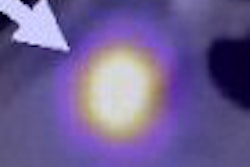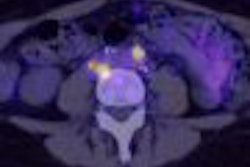The results of an analysis of ventilation/perfusion (V/Q) scans performed over a seven-year period reinforce the recommendations of the Prospective Investigation of Pulmonary Embolism Diagnosis (PIOPED) II trial, according to researchers from Rhode Island.
In the study, 96.5% of 315 pregnant women presenting with symptoms of pulmonary embolism (PE) in all three trimesters had PE ruled out with a V/Q scan, noted Dr. Don Yoo, director of nuclear medicine at the Miriam Hospital in Providence. He presented the study results at the 2007 RSNA meeting in Chicago.
The use of V/Q scans to diagnose pulmonary embolisms has diminished dramatically, superseded by CT pulmonary angiography (CTPA), which is rapid and efficient and has a sensitivity and specificity between 94% and 100%. In a 2003 Society of Thoracic Radiology member survey, 53% of respondents stated that they performed CTPA rather than V/Q scanning on pregnant women (American Journal of Roentgenology, December 2003, Vol. 181:6, pp. 1495-1498).
However, in recommendations and guidelines first published in December 2006, 69% of the PIOPED II investigators recommended that pulmonary scintigraphy be performed in lieu of CTPA to rule out PE in pregnant women (Radiology, January 2007, Vol. 242:1, pp. 15-21).
Radiation issue
Controversy exists about whether the absorbed radiation dose to a fetus with a V/Q scan is greater than that from a CTPA study, Yoo noted. "The radiation dose to the fetus will be affected by the technical aspects of how a V/Q scan or CTPA study is performed and the trimester of the pregnancy," he said.
"There is no controversy that a V/Q scan substantially reduces the radiation to the breast compared to a CTPA study," Yoo added. "While there have been no clinical studies about the risk of breast cancer from radiation exposure during pregnancy, it is reasonable to assume that the proliferating breast tissue of a pregnant woman would be at greater risk."
In 2005, J. Valmai Cook, a consultant radiologist with Epsom and St. Helier University Hospitals NHS Trust in Carshalton, Surrey, U.K., and John Kyriou, a radiation protection adviser at St. George's Hospital in London, noted that the absorbed dose (10 mGy) to the breast for a CTPA procedure is 40 times that of the absorbed dose (0.28 mGy) for a perfusion scan (British Medical Journal, August 6, 2005, Vol. 331:7512, p. 350).
V/Q scan an 'excellent study'
Yoo and his colleagues reviewed the findings of 315 pregnant patients who had V/Q scans performed after a chest radiograph from 1999 through 2006 at Rhode Island Hospital/Warren Alpert Medical School of Brown University in Providence. Of these, 236 patients (74.9%) had normal lung perfusion scans using technetium-99m macroaggregated albumin (Tc-99m MAA). Ninety-eight percent of these patients also had normal chest radiographs.
Thirty-eight patients (12%) had low probability lung perfusion scans, while 86% of the group also had normal chest radiographs.
The remaining 14 patients required additional ventilation lung scans using xenon 133 (Xe-133) to evaluate the defects identified on the perfusion lung scans. Of these, three patients (0.95%) had low probability V/Q scans, 10 patients (3.17%) had intermediate probability V/Q scans, and one patient (0.3%) had a high probability V/Q scan.
A total of 15 patients had CTPA studies and one patient had a conventional pulmonary angiogram for further evaluation of possible PE after the lung perfusion scans or V/Q scans were performed. The results of these studies were negative. The average radiation dose from V/Q scans was 0.035 rads and 0.014 rads from CTPA studies.
"Based on our analysis, V/Q scans remain an excellent study to make or rule out the diagnosis of pulmonary embolism in pregnant women," Yoo said. "While pulmonary embolism is the leading cause of death in women during pregnancy, it occurs in only one out of 1,500 pregnancies. Many women present with the common pregnancy symptoms of chest pain and shortness of breath. PE will be ruled out with the vast majority."
"The analysis we conducted proved that almost 97% of the time, a V/Q scan will rule out PE and avoid the unknown risks of excessive radiation to the maternal breast and potential problems from IV contrast (allergic reactions and renal failure)," he said.
By Cynthia Keen
AuntMinnie.com contributing writer
February 15, 2008
Related Reading
Multicenter trial supports CTPA versus V/Q for PE, December 18, 2007
Low-dose CT yields equivalent value for PE in pregnancy, November 27, 2007
V/Q scan finding reliably excludes pulmonary embolism, September 28, 2007
Researchers scrutinize CTA for pulmonary embolism, July 16, 2007
Pulmonary embolism an uncommon cause of COPD flare, March 6, 2007
Copyright © 2008 AuntMinnie.com



















